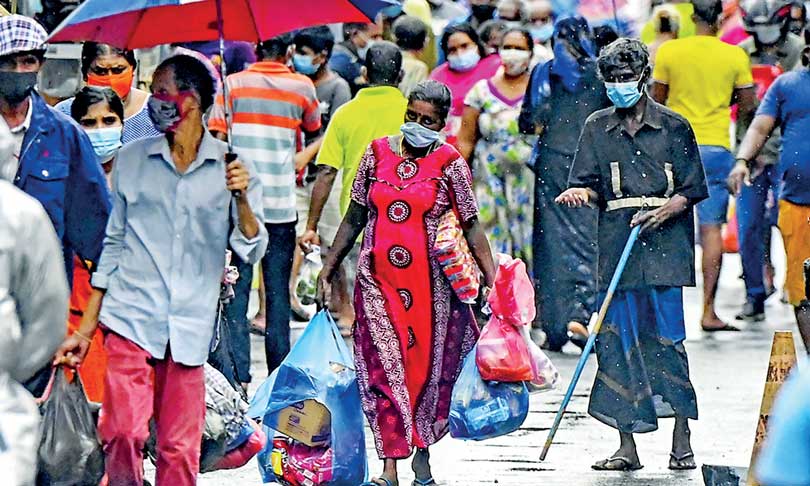Friday Apr 18, 2025
Friday Apr 18, 2025
Tuesday, 31 December 2024 00:00 - - {{hitsCtrl.values.hits}}

If there is one big lesson to be learned, it is that there are no shortcuts to carving out a real path out of the depression
The problem, however, cannot be resolved simply by critiquing the IMF. Rather, a new macroeconomic framework is required to identify and resolve the specific aspects of the depression in Sri Lanka. This approach requires thinking the short run solutions of relief and stimulus together with a long run development vision. Historically, of course, the field of development economics has held that poor countries need to generate enough of a surplus that can be invested in sectors of the economy capable of producing robust growth, especially industry
 One of the most frustrating features of Sri Lanka’s crisis is the fact that, in addition to the fiscal pressure imposed by the International Monetary Fund (IMF), there has hardly been any revision of the macroeconomic assumptions that frame policy interventions. They should be designed for relief and recovery in a far more robust sense. But under the current circumstances, the establishment cheers improvement in a few surface indicators such as inflation and the exchange rate. Nevertheless, the reality is that Sri Lanka has not overcome its economic depression.
One of the most frustrating features of Sri Lanka’s crisis is the fact that, in addition to the fiscal pressure imposed by the International Monetary Fund (IMF), there has hardly been any revision of the macroeconomic assumptions that frame policy interventions. They should be designed for relief and recovery in a far more robust sense. But under the current circumstances, the establishment cheers improvement in a few surface indicators such as inflation and the exchange rate. Nevertheless, the reality is that Sri Lanka has not overcome its economic depression.
More worryingly, the current framework for debt restructuring in fact threatens to extend the slump. For all the talk of a deal with bondholders, for example, paying off creditors and getting Sri Lanka back into the capital markets by the conclusion of the IMF program in 2027 is hardly a solution for the majority still reeling from the crisis. That includes the severe underperformance of the economy compared to its pre-crisis trajectory.
The problem, however, cannot be resolved simply by critiquing the IMF. Rather, a new macroeconomic framework is required to identify and resolve the specific aspects of the depression in Sri Lanka. This approach requires thinking the short run solutions of relief and stimulus together with a long run development vision. Historically, of course, the field of development economics has held that poor countries need to generate enough of a surplus that can be invested in sectors of the economy capable of producing robust growth, especially industry.
As eminent economist Sukhamoy Chakravarty noted in ‘Development Planning: The Indian Experience’, it was “the classic issue of ‘jam today versus jam tomorrow’.” But in the case of Sri Lanka, investment in heavy industry, especially, did not necessarily work because of the simultaneous difficulty overcoming the constraint on foreign exchange to import the necessary intermediate and capital goods.
Before Sri Lanka could address its development obstacles in a more effective way, it was hit by the global economic crisis of the 1970s. We could argue that Sri Lanka tried to pursue two paths out of the crisis: 1) tentative measures to improve self-sufficiency in essential goods, especially food, to maintain basic living standards for people and 2) global efforts such as proposals for a New International Economic Order (NIEO) to secure better prices for the country’s primary commodity exports, especially tea and rubber. In the case of the first strategy, it was derailed by a complex political trajectory culminating in the wave of popular anger and frustration directed towards the government led by Sirimavo Bandaranaike. The United National Party capitalised on its time out of power to offer the ‘open economy’ as a solution. Meanwhile, the second strategy was defeated by the global neoliberal counter-revolution led by the US.
No shortcuts
Naturally, we now look for analogies in the past to analyse the character of the present crisis. But if there is one big lesson to be learned, it is that there are no shortcuts to carving out a real path out of the depression, given that it is related to, yet distinct from, the ‘longue durée’ question of dependency. The reality is that Sri Lanka cannot look forward to any easy solutions, whether in terms of a sudden inflow of productive capital from abroad or pushing up productivity by exhorting a mythical class of indigenous entrepreneurs—as opposed to rentiers—to organise their businesses better.
Because of the constraints of the existing IMF program and its punishing primary surplus targets, public investment has cratered. At the same time, the industrial sector has undergone a severe contraction since the start of the crisis, from which it has yet to recover. As John Maynard Keynes demonstrated, without deficit financing by the government, capitalists are unlikely to invest more in such a situation.
Yet Sri Lanka faces two problems. Or rather one contains the other. Given their constitutive interests in extraction, neither the IMF nor rich countries in general will simply lend money to Sri Lanka to engage in the kind of deficit financing needed to recover from the depression. But even if they were willing, the reality is that, as the original development economists correctly identified, the structure of the economy would create real pressure on prices even if Sri Lanka could invest in the kind of massive public works that allowed the metropolitan industrial countries to exit the Great Depression of the 1930s.
Sri Lanka then must consider alternative measures that may not necessarily enable the economy to return to a pre-crisis level of growth in the short-term, and likely even the medium-term. Nevertheless, the key question is whether a new approach could at least put it on a more sustainable foundation in terms of creating tangible improvements in people’s livelihoods.
Political implications
How the problem is framed politically, to generate the appropriate incentives and mindset in the broader population, depends on the political skill of the national leadership. But in terms of material constraints, it would first and foremost require investment in the food system, with a strong emphasis on lowering the price of essential goods while creating enough economic activity to absorb surplus labour. The auxiliary industries that could accommodate that programme should promote the upgrading of skills and technological innovation, which contributes in the long run to economic dynamism and thus growth.
Still, the reality is that there is no policy that would be effective outside of a strong political emphasis on state intervention to encourage diverse methods of redistribution, not only fiscal. This strategy would depend on mobilising the population and sustaining the broader pressure on the capitalist class that is needed to compel it to invest in relevant sectors. If successful, that class itself would eventually be transformed away from its comprador outlook and orientation, enabling Sri Lanka to break with enduring patterns of dependency.
Meanwhile, post-industrial countries are now considering many different instruments under the wide rubric of industrial policy. But the reality is that their goals are inevitably different from Sri Lanka’s because of the structural character of their economies. Thus, the kinds of solutions that Sri Lanka can consider when framed in terms of industrial policy must be specific to the country and the needs of its working people. That means finding a way out of the depression by generating jobs and incomes while lowering the cost of essential goods. These are challenges intrinsic to an underdeveloped economy.
If Sri Lanka, for example, currently imports a wide variety of consumer items, which put pressure on the balance of payments, then it would need to consider other ways of incentivising the middle class while prioritising inputs needed to strengthen production for self-sufficiency in essential goods.
This approach would require saving on imports as much as producing exports, as Sri Lanka’s leading development thinker Gamani Corea himself once noted even during the heyday of hyper-globalisation in the 1990s. It is all well and good to talk exports as a way of stimulating the search for new productive methods. But Sri Lanka will not find salvation abroad. Instead, the country must embark on a new phase of policy experimentation.
At the same time, we can discipline our thinking by going back to the bedrock of development economics as it has been applied to Sri Lanka. Moreover, given the scale of the current crisis, the solution will inevitably require a major shift in social relations with a heavy emphasis on agrarian mobilisation. The upside is that, in the long run, that approach could also produce a balance of forces more conducive to development in the real sense.
Discover Kapruka, the leading online shopping platform in Sri Lanka, where you can conveniently send Gifts and Flowers to your loved ones for any event including Valentine ’s Day. Explore a wide range of popular Shopping Categories on Kapruka, including Toys, Groceries, Electronics, Birthday Cakes, Fruits, Chocolates, Flower Bouquets, Clothing, Watches, Lingerie, Gift Sets and Jewellery. Also if you’re interested in selling with Kapruka, Partner Central by Kapruka is the best solution to start with. Moreover, through Kapruka Global Shop, you can also enjoy the convenience of purchasing products from renowned platforms like Amazon and eBay and have them delivered to Sri Lanka.
Discover Kapruka, the leading online shopping platform in Sri Lanka, where you can conveniently send Gifts and Flowers to your loved ones for any event including Valentine ’s Day. Explore a wide range of popular Shopping Categories on Kapruka, including Toys, Groceries, Electronics, Birthday Cakes, Fruits, Chocolates, Flower Bouquets, Clothing, Watches, Lingerie, Gift Sets and Jewellery. Also if you’re interested in selling with Kapruka, Partner Central by Kapruka is the best solution to start with. Moreover, through Kapruka Global Shop, you can also enjoy the convenience of purchasing products from renowned platforms like Amazon and eBay and have them delivered to Sri Lanka.